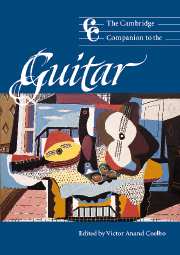Book contents
- Frontmatter
- Part I New guitar histories and world traditions
- Part II Jazz, roots, and rock
- Part III Baroque and classical guitar today
- 10 Radical innovations, social revolution, and the baroque guitar
- 11 Perspectives on the classical guitar in the twentieth century
- 12 Antonio Stradivari and baroque guitar making
- Glossary
- Notes
- Select bibliography
- General index
- Index of song and album titles
12 - Antonio Stradivari and baroque guitar making
from Part III - Baroque and classical guitar today
Published online by Cambridge University Press: 28 September 2011
- Frontmatter
- Part I New guitar histories and world traditions
- Part II Jazz, roots, and rock
- Part III Baroque and classical guitar today
- 10 Radical innovations, social revolution, and the baroque guitar
- 11 Perspectives on the classical guitar in the twentieth century
- 12 Antonio Stradivari and baroque guitar making
- Glossary
- Notes
- Select bibliography
- General index
- Index of song and album titles
Summary
Antonio Stradivari (b. 1644; d. Cremona, 1737) is the most celebrated violin maker in history, yet it is not generally known that he also made a variety of lutes, mandolas, mandolins, guitars, and harps. Compared to the approximately 600 of Stradivari's violins, violas, and cellos that have survived, only a few mandolins and guitars and one harp are extant. Of the guitars, probably the best-known example, dated 1688, is in the Hill collection at the Ashmolean Museum in Oxford (see Plates 21 a–d). Other examples include the “Sabionari” (1679), in a private collection in Italy; the “Giustiniani” (1681), also in a private collection in Italy; and the “Rawlins” (1700), in the Shrine to Music Museum in Vermillion, South Dakota. Doubts have been cast on two others: the “Canobio-Pagliari,” apparently by another maker though bearing a label “Revisto e coretto da me Antonio Stradivari in Cremona l'anno 1681” (“Revised and corrected by me, Antonio Stradivari in Cremona in the year 1681”), whereabouts unknown; and the “Vuillaume” (1711), in the Musée de la Musique in Paris. A guitar neck inscribed “ant:sstradivarivs/cremonen:sf.1675” is privately owned in the United Kingdom.
To better understand Stradivari's contribution to the craft of guitar making, it is helpful to trace the development of the baroque guitar and to examine early writings that describe the guitar's design from a theoretical standpoint. Only two pre-baroque guitars and three early vihuelas are extant. One guitar, in the Royal College of Music (London), is labeled in Portuguese “Belchior Dias made (by) me / Lisbon month of December 1581” and also inscribed “bchior dias lxa [Belchior Dias Lisbon]”; a similar, though slightly larger and unsigned instrument (formerly in the Robert Spencer collection) is now in a private collection in the United States.
- Type
- Chapter
- Information
- The Cambridge Companion to the Guitar , pp. 207 - 228Publisher: Cambridge University PressPrint publication year: 2003
- 2
- Cited by



